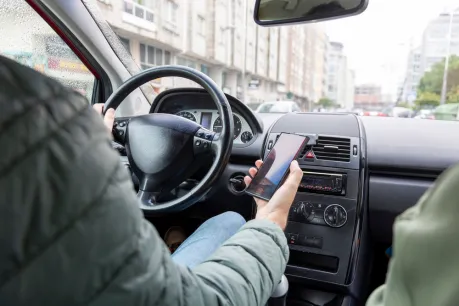The Dangers of Texting and Driving: Real-Life Stories and Statistics

Injured?
Be their hero behind the wheel. Hear John Morgan’s powerful message on safe driving—click here to watch.
Our phones buzz, and we impulsively react—even behind the wheel.
It could be an important message, and it would only take a second to check. But here’s the truth. Every time you glance down at your phone while driving, you're not just risking your own safety; you’re also teaching those little eyes in the back seat that texting while driving is okay. Spoiler alert: it’s not.
Kids often look up to their parents like superheroes, believing they can do anything. So, when you’re behind the wheel, what message are you sending? And more importantly, what risks are you taking?
The Eye-Opening Statistics
Texting and driving isn’t just dangerous—it’s deadly. According to the National Highway Traffic Safety Administration (NHTSA), distracted driving claimed over 3,000 lives in 2021 alone. Of those distracted driving incidents, texting is one of the most dangerous because it requires your visual, manual, and cognitive attention. In short, it takes your eyes, hands, and mind off the road—a deadly trifecta.
- 5 seconds is the average time a driver takes their eyes off the road to send or read a text. At 55 mph, that's like driving the length of a football field blindfolded. Now imagine doing that with your kids in the back seat.
- Texting while driving increases the risk of a crash by 23 times compared to driving without distractions.
- 1 in 4 car accidents in the U.S. is caused by texting and driving, according to the National Safety Council.
Now, those numbers are scary, but they’re just numbers—until they become part of a real-life story.
Real-Life Stories: More Than Just a Stat
Disclaimer: The following stories are real-life examples of the dangers of distracted driving. These individuals were not our clients; we are sharing their stories solely for educational purposes.
Two-Time Distracted Driver
Amanda Clark was a teenager who wrote about her first experience with a texting and driving accident. Her Chevy Trailblazer rolled three times as she was checking her phone. While the car had landed on its roof, she was able to walk away from the crash.
Fast forward to one year later, Amanda did not seem to learn her lesson. She was texting on her phone when she experienced a violent and fatal tragedy. Found unresponsive by paramedics, Amanda passed away the next day.
A Fatal Text
In 2018, high school senior Camryn Lunsford was driving home from work. She was just 26 days from turning 18 and graduating in three months.
As she texted a friend, she drove right under an 18-wheeler in front of her, and resulted in a fatal car accident.
Why Texting and Driving Is Extra Risky for Kids
When you text and drive, you’re not just endangering your own life. If your kids are in the car, they’re along for the ride. Studies show that children of parents who engage in risky driving behaviors, like texting, are more likely to adopt those habits when they become drivers themselves. It's the classic "monkey see, monkey do" effect, and in this case, the stakes couldn’t be higher.
Clever Tips to Break the Habit (Because We Get It, It’s Hard!)
It’s not easy to break the texting-and-driving habit, especially when the temptation of a buzzing phone is just inches away. But you’re stronger than the pull of that notification—remember, superhero! Here are some clever ways to keep your eyes on the road where they belong:
- Use "Do Not Disturb" mode: Most phones have a feature that silences notifications while you’re driving. Set it and forget it.
- Out of sight, out of mind: Stick your phone in the glove compartment, backseat, or trunk (if you’re feeling really ambitious!).
- App solutions: Apps like "DriveSafe.ly" or "LifeSaver" will auto-respond to texts so your friends know you’re behind the wheel and can't reply.
- Make it a family challenge: Get your kids involved! Create a reward system for everyone in the family who goes the longest without touching their phone in the car.
The Science Behind Why Texting While Driving Is So Dangerous
Ever wonder why texting while driving is particularly risky? The answer lies in how our brains handle multitasking. Despite what we may think, humans aren’t designed to focus on two things at once—especially complex tasks like driving and reading a text. When you send or read a text, your brain shifts focus away from driving, reducing your reaction time by up to 35%, according to studies. In those few seconds, you’re essentially driving blind. At 55 mph, if you glance down at your phone for just 5 seconds, you've traveled the length of a football field without looking at the road.
This division of cognitive energy also impairs your ability to process what’s happening around you—making it more likely that you'll miss crucial changes, like a car suddenly braking or a pedestrian crossing. The science is clear: when your brain is focused on texting, it's not focused on driving.
Legal Consequences of Texting While Driving
The legal ramifications of texting while driving are severe and can vary by state. In states like California, Florida, and New York, drivers caught texting can face hefty fines, points on their licenses, and even increased insurance rates. But it doesn’t stop there—if you cause an accident while texting, the penalties can escalate. You could be liable for civil lawsuits, face criminal charges, and even serve jail time if your negligence leads to serious injury or death.
Texting-related accidents aren’t just traffic violations; they can result in life-altering legal and financial consequences. Always check your state's specific laws and know that the risks far outweigh the perceived convenience of a quick message.
How Parents Can Set Boundaries and Lead by Example
Parents play a pivotal role in modeling safe driving habits for their kids. If your children see you texting while driving, they'll be more likely to mimic that behavior when they start driving. The best way to teach safe habits is to lead by example. Set specific "no phone" rules in your vehicle and stick to them. Explain to your kids why these rules exist and the risks involved with texting behind the wheel.
Another actionable tip? Establish phone-free zones in the car. If you're using GPS, set the destination before you start driving, and let a passenger handle any texts or calls. When your kids see you following these guidelines, they’ll understand that safety comes first.
Texting and Driving vs. Other Forms of Distracted Driving
Sure, there are lots of distractions while driving. Eating, adjusting the radio, chatting with passengers—but texting takes the cake in terms of danger. Why? Because it involves all three types of distraction:
- Visual: You take your eyes off the road.
- Manual: You take your hands off the wheel.
- Cognitive: You take your mind off driving.
Other distractions might involve one or two of these elements, but texting covers all three, making it especially dangerous. While eating a burger might mean you have one hand on the wheel, texting means neither your hands nor your focus is on driving—an incredibly risky combination.
How Technology Can Help: Tools for Safer Driving
Believe it or not, the same technology that leads to distracted driving can also help prevent it. For example:
- In-car systems: Many modern vehicles come with systems that allow hands-free texting or completely disable the ability to text while the car is in motion.
- Apps: Several apps, like DriveSafe.ly and AT&T DriveMode, are designed to block texts or auto-reply while you're driving, preventing the temptation to check your phone.
- Rewards programs: Some insurance companies and apps reward drivers for staying off their phones, offering everything from gift cards to reduced premiums.
By leveraging these tools, you can reinforce safe driving behaviors for both yourself and your teen drivers.
What Are the Long-Term Consequences of Texting and Driving?
Beyond the immediate risk of causing an accident, texting and driving can result in long-term consequences like losing your driver’s license, and facing criminal charges.
In the worst-case scenario, the long-term consequences could mean the unthinkable: causing injury or even killing someone, possibly even a loved one in your passenger seat. Imagine having to live with that guilt, if you even survive the crash yourself.
Are There Any Apps or Tools That Help Prevent Texting While Driving?
Yes! Apps like Drivemode and LifeSaver help prevent texting by silencing notifications or locking the phone while the car is in motion. This is a good practice to pass on to your children when they begin to take the wheel themselves.
How Can I Stop Myself From Texting While Driving if I Find It Difficult to Resist?
To avoid the temptation of checking your phone while your vehicle is in motion, try putting your phone in the glove box or trunk before driving. You can also enable Do Not Disturb mode or use an app that blocks texts while you're on the road.
What Is the Safest Way to Handle an Emergency Text While Driving?
If a text you receive while driving is truly an emergency, the safest option is to pull over to a safe location before checking your phone or responding to the text. It usually only takes a minute to do so, which is more than enough time to respond to an emergency message.
What Kind of Legal Trouble Can I Get Into if I Cause an Accident Due to Texting?
If you are caught texting while driving, in most states you could face hefty fines, be sued for damages in the case of an accident, and even face criminal charges depending on the severity of the accident. If there is evidence of you texting and behaving as a distracted driver, the legal trouble can be substantial.
How Do I Teach My Teenage Kids to Avoid Texting and Driving?
Start the conversation early. Set clear rules about phone use while driving and use apps that can monitor and block their phone while they’re behind the wheel. Most importantly, be the driver you want them to become. Remember, your child is always watching, and the actions you take have lasting impressions on them.
What Are Some Signs That Distracted Driving Is Becoming a Problem for Me or My Family?
Frequent near-misses, slow reaction times, or regularly feeling tempted to check your phone while driving are all signs that distracted driving might be an ongoing issue. Take steps to address it before it leads to an accident, especially to establish yourself as a better role model for your biggest fans: your kids.
It’s Time to Put the Phone Down—for You and Your Kids
We know it’s tempting to send a quick text or check that notification, but your kids are watching, and the example you set today will shape their habits tomorrow. Imagine the superhero moment you’ll create when you break the cycle of distracted driving and teach them that safety comes first. After all, what’s more powerful than keeping your family—and others—safe on the road?
If you've been involved in an accident caused by a distracted driver, Morgan & Morgan is here to fight for you. With over 35 years of experience, we’ve helped countless victims of reckless driving receive the compensation they deserve. Don’t wait—reach out to us today and let’s work together to keep our roads safer for everyone.

We've got your back
Injured?
Not sure what to do next?
We'll guide you through everything you need to know.

